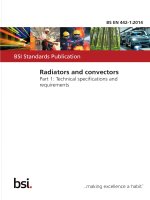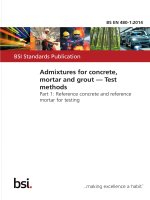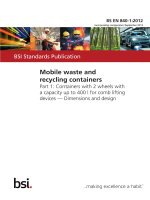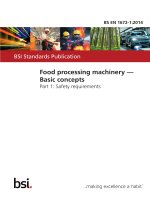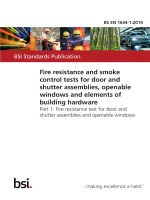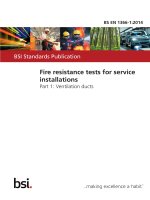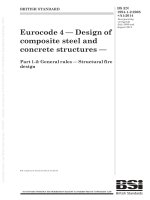Bsi bs en 62290 1 2014
Bạn đang xem bản rút gọn của tài liệu. Xem và tải ngay bản đầy đủ của tài liệu tại đây (1.19 MB, 34 trang )
BS EN 62290-1:2014
BSI Standards Publication
Railway applications — Urban
guided transport management
and command/control systems
Part 1: System principles and fundamental concepts
BRITISH STANDARD
BS EN 62290-1:2014
National foreword
This British Standard is the UK implementation of EN 62290-1:2014. It
is identical to IEC 62290-1:2014. It supersedes BS EN 62290-1:2006
which is withdrawn.
The UK participation in its preparation was entrusted to Technical
Committee GEL/9, Railway Electrotechnical Applications.
A list of organizations represented on this committee can be obtained on
request to its secretary.
This publication does not purport to include all the necessary provisions of
a contract. Users are responsible for its correct application.
© The British Standards Institution 2014.
Published by BSI Standards Limited 2014
ISBN 978 0 580 80179 2
ICS 35.240.60; 45.020; 45.060.01
Compliance with a British Standard cannot confer immunity from
legal obligations.
This British Standard was published under the authority of the
Standards Policy and Strategy Committee on 30 September 2014.
Amendments/corrigenda issued since publication
Date
Text affected
EUROPEAN STANDARD
EN 62290-1
NORME EUROPÉENNE
EUROPÄISCHE NORM
September 2014
ICS 45.060
Supersedes EN 62290-1:2006
English Version
Railway applications - Urban guided transport management and
command/control systems - Part 1: System principles and
fundamental concepts
(IEC 62290-1:2014)
Applications ferroviaires - Systèmes de contrôle/commande
et de gestion des transports guidés urbains Partie 1: Principes système et concepts fondamentaux
(CEI 62290-1:2014)
Bahnanwendungen - Betriebsleit- und
Zugsicherungssysteme für den städtischen
schienengebundenen Personennahverkehr Teil 1: Systemgrundsätze und grundlegende Konzepte
(IEC 62290-1:2014)
This European Standard was approved by CENELEC on 2014-08-14. CENELEC members are bound to comply with the CEN/CENELEC
Internal Regulations which stipulate the conditions for giving this European Standard the status of a national standard without any alteration.
Up-to-date lists and bibliographical references concerning such national standards may be obtained on application to the CEN-CENELEC
Management Centre or to any CENELEC member.
This European Standard exists in three official versions (English, French, German). A version in any other language made by translation
under the responsibility of a CENELEC member into its own language and notified to the CEN-CENELEC Management Centre has the
same status as the official versions.
CENELEC members are the national electrotechnical committees of Austria, Belgium, Bulgaria, Croatia, Cyprus, the Czech Republic,
Denmark, Estonia, Finland, Former Yugoslav Republic of Macedonia, France, Germany, Greece, Hungary, Iceland, Ireland, Italy, Latvia,
Lithuania, Luxembourg, Malta, the Netherlands, Norway, Poland, Portugal, Romania, Slovakia, Slovenia, Spain, Sweden, Switzerland,
Turkey and the United Kingdom.
European Committee for Electrotechnical Standardization
Comité Européen de Normalisation Electrotechnique
Europäisches Komitee für Elektrotechnische Normung
CEN-CENELEC Management Centre: Avenue Marnix 17, B-1000 Brussels
© 2014 CENELEC All rights of exploitation in any form and by any means reserved worldwide for CENELEC Members.
Ref. No. EN 62290-1:2014 E
BS EN 62290-1:2014
EN 62290-1:2014
-2-
Foreword
The text of document 9/1913/FDIS, future edition 2 of IEC 62290-1, prepared by IEC/TC 9 "Electrical
equipment and systems for railways" was submitted to the IEC-CENELEC parallel vote and approved
by CENELEC as EN 62290-1:2014.
The following dates are fixed:
–
latest date by which the document has to be implemented at
national level by publication of an identical national
standard or by endorsement
(dop)
2015-05-14
–
latest date by which the national standards conflicting with
the document have to be withdrawn
(dow)
2017-08-14
This document supersedes EN 62290-1:2006.
Attention is drawn to the possibility that some of the elements of this document may be the subject of
patent rights. CENELEC [and/or CEN] shall not be held responsible for identifying any or all such
patent rights.
Endorsement notice
The text of the International Standard IEC 62290-1:2014 was approved by CENELEC as a European
Standard without any modification.
BS EN 62290-1:2014
EN 62290-1:2014
-3-
Annex ZA
(normative)
Normative references to international publications
with their corresponding European publications
The following documents, in whole or in part, are normatively referenced in this document and are
indispensable for its application. For dated references, only the edition cited applies. For undated
references, the latest edition of the referenced document (including any amendments) applies.
NOTE 1
When an International Publication has been modified by common modifications, indicated by (mod),
the relevant EN/HD applies.
NOTE 2
Up-to-date information on the latest versions of the European Standards listed in this annex is
available here: www.cenelec.eu.
Publication
Year
Title
EN/HD
Year
IEC 62236
series
Railway applications - Electromagnetic
compatibility
-
-
IEC 62278
-
Railway applications - Specification and
demonstration of reliability, availability,
maintainability and safety (RAMS)
-
-
IEC 62279
-
Railway applications - Communications,
signalling and processing systems Software for railway control and protection
systems
-
-
IEC 62280
-
Railway applications - Communication,
signalling and processing systems - Safety
related communication in transmission
systems
-
-
IEC 62290-2
-
Railway applications - Urban guided
transport management and
command/control systems Part 2: Functional requirements
specification
EN 62290-2
-
IEC 62425
-
Railway applications - Communication,
signalling and processing systems - Safety
related electronic systems for signalling
-
-
–2–
BS EN 62290-1:2014
IEC 62290-1:2014 © IEC 2014
CONTENTS
INTRODUCTION ..................................................................................................................... 6
1
Scope .............................................................................................................................. 9
2
Normative references ...................................................................................................... 9
3
Terms, definitions and abbreviations ............................................................................... 9
3.1
Terms and definitions............................................................................................ 10
3.2
Abbreviations ........................................................................................................ 14
4
Concepts ....................................................................................................................... 15
4.1
Urban guided transport (UGT) ............................................................................... 15
4.1.1
General ......................................................................................................... 15
4.1.2
Operations ..................................................................................................... 15
4.1.3
Operational facilities ...................................................................................... 15
4.1.4
Rolling stock .................................................................................................. 16
4.1.5
Staff .............................................................................................................. 16
4.1.6
Passengers ................................................................................................... 16
4.2
Grade of automation ............................................................................................. 16
4.2.1
Descriptions .................................................................................................. 16
4.2.2
Implementation of grades of automation ........................................................ 18
4.2.3
Grades of automation covered by UGTMS ..................................................... 18
4.3
Operation management and supervision ............................................................... 19
4.4
Interoperability, interchangeability, compatibility and adaptability .......................... 19
4.4.1
General ......................................................................................................... 19
4.4.2
Interoperability............................................................................................... 19
4.4.3
Interchangeability .......................................................................................... 19
4.4.4
Compatibility .................................................................................................. 19
4.4.5
Adaptability ................................................................................................... 20
5
System environment and boundaries ............................................................................. 20
6
General requirements and description of the basic functions ......................................... 21
6.1
General requirements ........................................................................................... 21
6.1.1
System approach ........................................................................................... 21
6.1.2
RAMS requirements ....................................................................................... 21
6.1.3
Electromagnetic compatibility ........................................................................ 21
6.1.4
Energy saving ................................................................................................ 21
6.1.5
Local conditions ............................................................................................. 21
6.1.6
Intermodality between networks ..................................................................... 22
6.1.7
Interoperability between neighbouring UGTMS fitted networks ....................... 22
6.1.8
Measures to ensure the movement of passengers with reduced mobility ........ 22
6.1.9
Nominal mode, degraded modes, emergency situation .................................. 22
6.1.10
Basic system performances ........................................................................... 22
6.1.11
Requirements for upgrading GOA .................................................................. 23
6.1.12
Requirements for adding new parts of line ..................................................... 23
6.2
Description of the basic functions ......................................................................... 23
6.2.1
General ......................................................................................................... 23
6.2.2
Basic functions for train operation.................................................................. 23
6.2.3
Basic functions for operation management and supervision ........................... 26
Bibliography .......................................................................................................................... 29
BS EN 62290-1:2014
IEC 62290-1:2014 © IEC 2014
–3–
Figure 1 – The three-step process followed by the UGTMS standard ...................................... 8
Figure 2 – Example of track layout ........................................................................................ 16
Figure 3 – System environment ............................................................................................. 20
Table 1 – Grades of automation ............................................................................................ 17
–6–
BS EN 62290-1:2014
IEC 62290-1:2014 © IEC 2014
INTRODUCTION
IEC 62290 standard series specifies the functional, system and interface requirements for the
command, control, and management systems intended to be used on urban, guided
passenger transport lines and networks. This series does not apply to lines that are operated
under specific railway regulations, unless otherwise specified by the authority having
jurisdiction.
These systems are designated here as Urban Guided Transport Management and
Command/Control Systems (UGTMS). UGTMS cover a wide range of operations needs from
non-automated (GOA1) to unattended (GOA4) operation. A line may be equipped with
UGTMS on its full length or only partly equipped.
This series does not specifically address security issues. However, aspects of safety
requirements may apply to ensuring security within the urban guided transit system.
The main objective of this series is to achieve interoperability, interchangeability and
compatibility.
This series is a recommendation for those transport authorities wishing to introduce
interoperable, interchangeable and compatible equipment.
It is the responsibility of the transport authority concerned in accordance with the authority
having jurisdiction to decide on how to apply this series and to take into account their
particular needs.
IEC 62290 series is also intended to support applications for upgrading existing signalling and
command control systems. In this case, interchangeability and compatibility could be ensured
only for the additional UGTMS equipment. Checking the possibility for upgrading existing
equipment and the level of interoperability is the responsibility of the transport authority
concerned.
Application of the series should take into account the differences between the various
networks operated in different nations. Those differences include operational and regulatory
requirements as well as different safety cultures.
This series defines a catalogue of UGTMS requirements split into mandatory and optional
functions. The functions used are based on the given grade of automation. By fulfilling the
requirements, a supplier can create one or more generic applications including all mandatory
functions and all or a subset of optional functions. A generic application will achieve
interoperability within the defined specific application conditions. Customising a generic
application will create a specific application taking into account of local conditions like track
layout and headway requirements. It is the choice of supplier and transport authority to add
additional functions to a generic or specific application. These additional functions are not
described in this series.
According to IEC 62278, it is the responsibility of the transport authority, in agreement with
the authority having jurisdiction, to decide, taking into account their risk acceptance principles
to conduct specific hazard and risk analysis for each specific application. The safety levels for
the functions of each specific application have to be determined by a specific risk analysis.
Terms such as "safety related command", "safety conditions", "safe station departure" are
mentioned without having performed any hazard analysis.
Standard series IEC 62290 is intended to consist of four parts:
–
Part 1 “System principles and fundamental concepts” provides an introduction to the
standard and deals with the main concepts, the system definition, the principles and the
BS EN 62290-1:2014
IEC 62290-1:2014 © IEC 2014
main basic functions of UGTMS
Command/Control Systems).
–7–
(Urban
Guided
Transport
Management
and
The three other parts correspond to the three steps (see Figure 1) required in the process of
specifying UGTMS and are to be used accordingly.
–
Part 2 “Functional requirements specification” specifies the functional requirements
associated to the basic functions provided by Part 1, within the system boundaries and
interfaces as defined in Figure 3 of Part 1.
The FRS (Functional Requirements Specification) identifies and defines the functions that
are necessary to operate an urban guided transport system. Two types of functions are
distinguished for a given grade of automation: mandatory functions (e.g. train detection)
and optional functions (e.g. interfaces to passenger information and passenger
surveillance systems). Requirements of functions have the same allocation, unless they
are marked otherwise.
–
Part 3 (under consideration) “System requirements specifications” deals with the
architecture of the system and the allocation of the requirements and functions identified
in part 2 to architecture constituents.
The SRS (System Requirements Specification) specifies the architecture of a UGTMS
system, with mandatory and optional constituents.
–
Part 4 (under consideration) “Interface specifications” deals with the definition of the
interfaces, as well as the data exchanged by them (FIS and FFFIS), for the interoperable
and interchangeable constituents identified in part 3.
For interfaces between UGTMS constituents, the logical interface or FIS (Functional
Interface Specification) and/or the physical and logical interface or FFFIS (Form Fit
Functional Interface Specification) will be considered.
NOTE The specific structures of part 3 and part 4 will be established following completion of part 2 to
accommodate optional and mandatory constituents, and to reflect local conditions. In principle, only one FIS or/and
FFFIS will be defined for the same interface. However, when justified in some cases, several FIS or several FFFIS
will be defined for the same interface.
–8–
BS EN 62290-1:2014
IEC 62290-1:2014 © IEC 2014
Functional
requirements
(FRS)
System requirements
(SRS)
Interface requirements
(FIS or/and FFFIS)
IEC 1339/06
Figure 1 – The three-step process followed by the UGTMS standard
Requirements are those necessary to fulfil all operational needs for safe and orderly operation
requested by transport authorities without regard to technical solutions.
The chosen level of detail in describing requirements enables customers as well as authorities
having jurisdiction to be assured that generic applications delivered by different suppliers will
cover at least the same functionality as specified in this part of IEC 62290.
Requirements which are established by this series are indicated clearly with a requirement
identification number related to the function to be covered.
BS EN 62290-1:2014
IEC 62290-1:2014 © IEC 2014
–9–
RAILWAY APPLICATIONS –
URBAN GUIDED TRANSPORT MANAGEMENT
AND COMMAND/CONTROL SYSTEMS –
Part 1: System principles and fundamental concepts
1
Scope
This part of IEC 62290 provides an introduction to the standard and deals with the main
concepts, the system definition, the principles and the basic functions of UGTMSs (Urban
Guided Transport Management and Command/Control Systems) for use in urban guided
passenger transport lines and networks. This part of IEC 62290 is applicable for new lines or
for upgrading existing signalling and command control systems.
This part of IEC 62290 is applicable to applications using:
•
continuous data transmission,
•
continuous supervision of train movements by train protection profile,
•
localisation of trains by external wayside equipment or reporting trains.
This standard is not applicable to existing command and control systems or projects in
progress prior to the effective date of this standard.
2
Normative references
The following documents, in whole or in part, are normatively referenced in this document and
are indispensable for its application. For dated references, only the edition cited applies. For
undated references, the latest edition of the referenced document (including any
amendments) applies.
IEC 62236 (all parts), Railway applications – Electromagnetic compatibility
IEC 62278, Railway applications – Specification and demonstration of reliability, availability,
maintainability and safety (RAMS)
IEC 62279, Railway applications – Communications, signalling and processing systems –
Software for railway control and protection systems
IEC 62280, Railway applications - Communication, signalling and processing systems - Safety
related communication in transmission systems
IEC 62290-2, Railway applications – Urban guided transport management
command/control systems – Part 2: Functional requirements specification
and
IEC 62425, Railway applications – Communication, signalling and processing systems –
Safety related electronic systems for signalling
3
Terms, definitions and abbreviations
For the purposes of this document, the following terms, definitions and abbreviations apply.
– 10 –
3.1
BS EN 62290-1:2014
IEC 62290-1:2014 © IEC 2014
Terms and definitions
3.1.1
additional function
function to be adapted to the specific requirements of each transport authority (due to local
rules or specific needs of the transport authority)
Note 1 to entry:
The components affected by this function are not necessarily interchangeable nor interoperable.
3.1.2
automatic mode
operation in semi-automated train operation (GOA2), driverless train operation (GOA3),
unattended train operation (GOA4)
3.1.3
command
order used to perform a function in a system
Note 1 to entry:
This order can originate from
–
a system operator,
–
an external system,
–
inside UGTMS;
this order can be sent:
–
to an external system,
–
inside UGTMS.
3.1.4
commercial speed
nominal average speed of passenger service trains between two terminus stations of the line
(dwell times at stations taken into account)
Note 1 to entry:
journey time.
Commercial speed is equal to the length between two terminus stations divided by the nominal
3.1.5
compatibility
capability of the UGTMS system to co-exist with other systems in the same transport network
without any interference
3.1.6
constituent
any elementary component, group of components, subassembly or complete assembly of
equipment incorporated or intended to be incorporated into UGTMS
3.1.7
control
process to keep the output of the system within defined parameters using commands for nonsafety related control or safety related control
Note 1 to entry: An example of non-safety related control is the process of commanding acceleration or braking to
maintain speed at x km/h ± y km/h. An example of safety related control is the process of commanding the
emergency brakes if the speed exceeds the predefined speed limit.
3.1.8
driving on sight
manual driving carried out at a speed that allows the driver to stop the train before reaching
any obstacle on the track
BS EN 62290-1:2014
IEC 62290-1:2014 © IEC 2014
– 11 –
3.1.9
emergency brake
brake or combination of brakes which ensures that the train will stop with the brake rate
agreed between authority having jurisdiction, transport authority and train manufacturer
3.1.10
generic application
application which contains all mandatory and all or a subset of optional functions, with
predefined configurability and customisable for different specific applications
3.1.11
generic product
product independent of applications, fulfilling predefined boundary conditions, interfaces and
functionality (black box)
EXAMPLES: point machines, axle counters, real-time operating systems, fail-safe computer platforms without
application software.
3.1.12
grade of automation
automation level of train operation, in which Urban Guided Transport (UGT) can be operated,
resulting from sharing responsibility for given basic functions of train operation between
operations staff and system
3.1.13
interchangeability
capability of system components identified in this standard to be procured from any number of
suppliers and replaced without any substantial change in functionality or performance
Note 1 to entry:
architecture.
It also allows the system to adapt to technology evolutions without significant modification to its
3.1.14
interlocking
interdependent liaison between the control levers or the electrical control circuits of different
apparatus such as points, signals, which makes it impossible to place them in positions which
are unsafe
Note 1 to entry:
In English, the term “interlocking” refers also to the place where interlocking is achieved.
Note 2 to entry:
a pair of points.
In French, the term “enclenchement” refers also to the individual locking of an apparatus such as
Note 3 to entry: For the purposes of this standard the term “interlocking” also refers to an apparatus ensuring the
interlocking functionality.
[SOURCE: IEC 60050-821:1998, 821-05-02]
3.1.15
interoperability
ability of a transport network to operate trains and infrastructures to provide, accept and use
services so exchanged without any substantial change in functionality or performance
Note 1 to entry: This ability rests on all the regulatory, technical and operational conditions which must be met in
order to satisfy all the defined requirements applicable to the given grade of automation, irrespective of which
supplier provides which components or systems.
3.1.16
management
in UGTMS, it is the process by which:
–
to conduct scheduled, efficient and reliable train services
– 12 –
–
BS EN 62290-1:2014
IEC 62290-1:2014 © IEC 2014
to handle degraded modes and abnormal situations
3.1.17
mandatory function
function compulsory for any UGTMS application depending on the GOA and has to be
developed in compliance with the UGTMS requirements in order to obtain interchangeable
and interoperable components
Note 1 to entry:
Requirements of mandatory functions are also mandatory unless they are marked as optional.
3.1.18
mission
mission of a train
non-safety related instruction for guiding a train for a journey from one defined location (e.g.
terminal station, transfer track) to another defined location including intermediate stops for
passenger transfer and possibly needed actions of a train (e.g. turn back) including time
constraints
3.1.19
movement authority
permission for a train to run, within the constraints of the infrastructure, up to a specific
location
3.1.20
non-operative UGTMS trains
non-UGTMS equipped trains and trains with inoperative UGTMS onboard equipment
3.1.21
operations control centre
OCC
centre from which operation of the line or the network is supervised and managed
3.1.22
operations control HMI
external central Human Machine Interface (HMI) (at Operations Control Centre OCC) and/or
local Human Machine Interface (HMI) (if any)
3.1.23
operations staff
staff authorised to perform tasks concerning train operation or direct service to passengers
3.1.24
optional function
function not compulsory for a defined grade of automation
Note 1 to entry: For a specific UGTMS application the transport authority has to decide if it uses it or not; if yes,
this function shall be compliant with the UGTMS requirements, in order to obtain interchangeable and interoperable
components.
3.1.25
reporting train
UGTMS-equipped train able to report its location and other relevant information
3.1.26
route
predetermined path for a traffic movement
[SOURCE: IEC 60050-821:1998, 821-01-22]
BS EN 62290-1:2014
IEC 62290-1:2014 © IEC 2014
– 13 –
3.1.27
safe places
areas within the network of an operator where evacuation of passengers can be performed,
depending on current operational conditions, with a minimum of risks to the passengers (e.g.
stations, refuges on the line)
3.1.28
service brake
braking applied by the driver or the train UGTMS onboard equipment to control train speed
Note 1 to entry:
This takes into account passengers comfort, economic and environmental considerations.
3.1.29
signal
– conventional visual or acoustic indication, generally concerning the movements of railway
vehicles and transmitted to the staff entrusted to observe it
–
apparatus by means of which a conventional indication is given
[SOURCE: IEC 60050-821:1998, 821-02-01]
3.1.30
specific application
application designed for a particular realisation based on a customised generic application
3.1.31
spot transmission
track to train transmission that can only take place when the train passes the information
point
3.1.32
station
place where trains stop to allow passengers to embark and disembark
3.1.33
supervise
to monitor the performance and the status of a system and initiate control when necessary
3.1.34
train detection
safe recognition of the presence or absence of any trains on a defined section of the track or
at a given point
3.1.35
train integrity
state of the train being complete (no car unduly separated from the train)
3.1.36
train stop
device located adjacent to a running rail which is so positioned that if the signal with which it
is associated is displaying danger it actuates the braking system of a train which passes this
signal; alternatively, when a line speed restriction exists, it may be used independently of a
signal
[SOURCE: IEC 60050-821:1998, 821-08-10]
3.1.37
transfer track
transition area between unequipped part of a network and UGTMS territory
– 14 –
BS EN 62290-1:2014
IEC 62290-1:2014 © IEC 2014
3.1.38
transport authority
entity which is responsible for safe and orderly operation of a transport system
3.1.39
UGTMS onboard equipment
UGTMS equipment installed on the train
3.1.40
UGTMS operations control equipment
UGTMS equipment performing centralised command/control, management and supervising
functions and providing interface for HMI
3.1.41
UGTMS wayside equipment
equipment not on board trains, set either at trackside locations or elsewhere along the line or
in the network
3.1.42
zone of protection
zone where no train is allowed to run, as a response to various kinds of incidents except
identified hazardous situations for which trains can leave the zone
3.2
Abbreviations
AC
Alternating Current
CCTV
Closed Circuit TeleVision
DC
Direct Current
DCS
Data Communication System
FFFIS
Form-Fit Functional Interface Specification
FIS
Functional Interface Specification
FPA
Flank Protection Area
FRS
Functional Requirements Specification
GOA
Grade Of Automation
HMI
Human Machine Interface
HVAC
Heating Ventilation and Air Conditioning
M
Mandatory
O
Optional
OCC
Operations Control Centre
OVL
Overlap
RAMS
Reliability, Availability, Maintainability and Safety
RD
Route Destination
REQ
Requirement
RO
Route Origin
SRS
System Requirements Specification
UGT
Urban Guided Transport
UGTMS
Urban Guided Transport Management and Command/Control System
UGTMS OB
Onboard UGTMS equipment
UGTMS WS
Wayside UGTMS equipment
BS EN 62290-1:2014
IEC 62290-1:2014 © IEC 2014
4
– 15 –
Concepts
4.1
Urban guided transport (UGT)
4.1.1
General
UGT is defined as a public transportation system in an urban environment with self-propelled
vehicles and operated on a guideway, which is segregated from general road and pedestrian
traffic.
Railway infrastructures which are part of a railway network operated under specific railway
regulations are excluded, unless otherwise specified by the authority having jurisdiction.
Trains of transport undertakings (e.g. underground/metro, tram, regional and suburban
operators) are included even if they are operated under specific railway regulations, when
they are designated to operate on UGTMS infrastructure. In this case, trains of different
transport undertakings shall fulfil the conditions of interoperability and the requirements given
by specific regulations.
4.1.2
Operations
Operation is considered as the totality of all means to effect the transportation of passengers,
including the training of operations staff and maintenance of installations and rolling stock.
Train operations include command and control of routes, passenger transfer, driving of trains
and also shunting.
4.1.3
Operational facilities
Operational facilities are all those installations and equipment which serve operations such as
(an example of track layout is shown in Figure 2):
–
electrotechnical installations (like traction power supply, lighting equipment, communication equipment, command and control system, management system, maintenance system,
etc.);
–
guideway for movement of trains (points, derailers, crossings, crossings with movable
frogs, level crossings, flood gates, platform tracks, tracks between stations, etc.). Platform
tracks and tracks between stations might be used for one way or bi-directional operation;
–
stations are places where passengers transfer between the wayside and a train is
achieved. A station comprises waiting area(s) (with optionally, installations for passenger
service and ticketing) and passenger transfer area(s) as interface between platform and
train;
–
sidings are considered as a place for storing rolling stock and turn back of trains. Sidings
are normally not used for passenger transport;
–
depots which are used for maintenance and storage of rolling stock and normally not used
for passenger transport.
BS EN 62290-1:2014
IEC 62290-1:2014 © IEC 2014
– 16 –
Depot
Flood gates
Station
Siding
Platform
track
Platform
track
Siding
Point
Track between
stations
Crossing
Level
crossing
IEC 1340/06
Figure 2 – Example of track layout
4.1.4
Rolling stock
Rolling stock is considered as a guided vehicle which may operate as a single unit or as a
composition of units. A unit may consist of one or more cars, which cannot be uncoupled
during train operation.
Trains are units of rolling stock operating as passenger or non-passenger trains consisting of
one or more units. If a train consists of more than one unit it can be split during train
operation.
4.1.5
Staff
Operations staff are notably persons who are involved directly in the process of passenger
transportation (like drivers, operators in OCC, supervisors on platforms or in OCC).
Maintenance staff are persons who are involved in maintenance of infrastructure and rolling
stock.
Rescue staff are persons who are involved in rescue of persons notably located inside
stations and rolling stock.
4.1.6
Passengers
Passengers are users of the transportation system, noted that there are specific passenger
needs for handicapped passengers, passengers with reduced mobility, children and
passengers with luggage.
4.2
Grade of automation
4.2.1
4.2.1.1
Descriptions
General
UGT can be operated at different grades of automation defined below. The definition of
grades of automation arises from apportioning responsibility for given basic functions of train
operation between operations staff and system.
The mandatory basic functions of train operation for a given grade of automation on a line or
network are defined in the following subclauses and Table 1.
Non-mandatory basic functions of train operation for a given grade of automation may also be
realised by the system.
The grade of automation will influence the requirements of operation, operational facilities,
rolling stock, staff. The requirements shall take into account the behaviour of passengers.
NOTE
x
x
x
x
x
x
x
x
x
x
x
x
x
x
system
system
system
system
system
system
system
system
GOA3
Driverless train
operation
system
system = shall be realised by UGTMS system
x
x
Detect fire/smoke and detect derailment, detect
loss of train integrity, manage passenger requests
(call/evacuation, supervision)
x
x
x = responsibility of operations staff (may be realised by UGTMS system)
Ensure detection
and management
of emergency
situations
Operate a train
x
x
x
Ensure safe starting conditions
x
Supervise the status of the train
x
Prevent injuries to persons between cars or
between platform and train
x
x
x
Control passengers doors
x
x
x
x
(partly supervised by
system)
Put in or take out of operation
x
Prevent collision with persons on tracks
Supervise
passenger
transfer
x
Prevent collision with obstacles
Supervise
guideway
x
x
Ensure safe speed
Control acceleration and braking
x
system
system
system
x
(points
command/control in
system)
Ensure safe separation of trains
Ensure safe route
GOA2
GOA1
GOA0
Semi-automated
train operation
Non-automated train
operation
On-sight train
operation
Drive train
Ensure safe
movement of
trains
Basic functions of train operation
Table 1 – Grades of automation
system and/or
staff in OCC
system
system
system
system
system
system
system
system
system
system
system
GOA4
Unattended train
operation
BS EN 62290-1:2014
IEC 62290-1:2014 © IEC 2014
– 17 –
– 18 –
4.2.1.2
BS EN 62290-1:2014
IEC 62290-1:2014 © IEC 2014
Grade of automation 0 (GOA0): On-sight train operation
In this grade of automation, the driver has full responsibility and no system is required to
supervise his activities. However, points and single tracks can be partially supervised by the
system.
4.2.1.3
Grade of automation 1 (GOA1): Non-automated train operation
In this grade of automation, the driver is in the front cabin of the train observing the guideway
and stops the train in the case of a hazardous situation. Acceleration and braking are
commanded by the driver in compliance with wayside signals or cab-signal. The system
supervises the activities of the driver. This supervision may be done at specific locations, be
semi-continuous or continuous, notably in respect of the signals and the speed. Safe
departure of the train from the station, including door closing, is the responsibility of the
operations staff.
4.2.1.4
Grade of automation 2 (GOA2): Semi-automated train operation
In this grade of automation, the driver is in the front cabin of the train observing the guideway
and stops the train in the case of a hazardous situation. Acceleration and braking is
automated and the speed is supervised continuously by the system. Safe departure of the
train from the station is the responsibility of the operations staff (door opening and closing
may be done automatically).
4.2.1.5
Grade of automation 3 (GOA3): Driverless train operation
In this grade of automation, additional measures are needed compared to GOA2 because
there is no driver in the front cabin of the train to observe the guideway and stop the train in
case of a hazardous situation.
In this grade of automation, a member of the operations staff is necessary onboard. Safe
departure of the train from the station, including door closing, can be the responsibility of the
operations staff or may be done automatically.
4.2.1.6
Grade of automation 4 (GOA4): Unattended train operation
In this grade of automation, additional measures are needed compared to GOA3 because
there are no onboard operations staff.
Safe departure of the train from the station, including door closing, has to be done
automatically.
More specifically, the system supports detection and management of hazardous conditions
and emergency situations such as the evacuation of passengers. Some hazardous conditions
or emergency situations, such as derailment or the detection of smoke or fire, may require
staff interventions.
4.2.2
Implementation of grades of automation
Different grades of automation may be used with the same train at different areas of the same
line.
The functions for different grades of automation have to be realised in an upgradeable way by
technical subsystems implemented on a common core architecture. UGTMS will address
basic functions identified in Table 1.
4.2.3
Grades of automation covered by UGTMS
UGTMS shall support GOA1, GOA2, GOA3 and GOA4.
BS EN 62290-1:2014
IEC 62290-1:2014 © IEC 2014
– 19 –
GOA0 is not covered by the UGTMS standard but may be used as a degraded grade in a
UGTMS environment.
4.3
Operation management and supervision
Operation management and supervision functions are described in 6.2.
4.4
Interoperability, interchangeability, compatibility and adaptability
4.4.1
General
A generic application of UGTMS shall be specified in such a manner as to optimise at the
same time interchangeability, interoperability, compatibility and adaptability.
4.4.2
4.4.2.1
Interoperability
Interoperability in a given grade of automation
In order to achieve interoperability within a given grade of automation, the onboard and
wayside equipment shall take into account the goals summarised below:
a) a train with a UGTMS system provided by supplier X can operate on a track equipped with
UGTMS wayside equipment supplied by Y;
b) a train with a UGTMS system provided by supplier X can be coupled with a train equipped
with a UGTMS system provided by supplier Y (provided rolling stock can be coupled);
c) UGTMS wayside equipment provided by supplier X and UGTMS wayside equipment
provided by supplier Y or Z on two adjacent portions of track can be interfaced with a
common OCC supplied by X, Y or Z;
d) a train with a UGTMS system provided by X, Y or Z can pass track boundaries X/Y, Y/Z
and X/Z without any operational or technical disturbance.
4.4.2.2
Interoperability with different grades of automation
When the grades of automation are different between the wayside equipment and the onboard
equipment, the UGTMS system shall be able to operate at the highest available common
grade.
4.4.2.3
Mixed operation
UGTMS shall not negatively affect the operation of non-UGTMS equipped trains. To ensure
the safe movement of non-UGTMS equipped trains, an additional system is necessary which
is outside UGTMS. If mixed operation is required, UGTMS shall interface to this additional
system.
4.4.3
Interchangeability
Interchangeability means that it is possible to replace any UGTMS constituent supplied by one
industry provider by a constituent supplied by another industry provider but designed
according to the same FFFIS and FIS specifications.
4.4.4
Compatibility
Compatibility means that there is no undesired interaction between the UGTMS system and
the existing infrastructure, trains and equipment. This characteristic is notably required for
ease of migration towards UGTMS.
BS EN 62290-1:2014
IEC 62290-1:2014 © IEC 2014
– 20 –
4.4.5
Adaptability
Adaptability means that the system allows, as far as possible, line extension and/or
throughput increase and/or rolling stock fleet evolution.
5
System environment and boundaries
UGTMS is an integrated train command, control and management system providing the
functions described in Clause 6. The system environment is shown in Figure 3. UGTMS shall
have capability to interface with all identified subsystems, if provided.
UGTMS
COMMAND, CONTROL &
MANAGEMENT
- Operations control HMI
- Trackside equipment (e.g. points,
signals, track circuits, axle counters,
wayside speed supervising devices,
neighbouring OCC, train stops, level
crossings)
- Existing interlocking
- Operation planning
INFO SYSTEMS
COMMUNICATIONS
- Voice communication (e.g. staff,
passenger communication – wayside,
stations and onboard)
- CCTV surveillance (wayside and
onboard)
- Passenger information system (wayside
and onboard)
STATION
- Auxiliaries (e.g. elevators/escalators)
- Fire detection/protection
- Platforms/track intrusion detection (e.g.
passenger on track)
- Platform Screen Doors and/or
End Doors
- Other equipment interfaces (e.g.
emergency handles, emergency call
devices, gap detection/closing devices,
dispatching /train ready to start keys)
- Operation control
equipment
- Wayside equipment
(includes spot
transmission
wayside/train)
- Onboard equipment
(includes location,
speed and time
measurement)
- Data communication
system (includes
wayside,
wayside/train and
train data
communication)
TRAIN
- Doors, propulsion, brakes, train length
device (e.g. couplers)
- Train HMI
- Obstacle, derailment, fire/smoke
detection devices
- Gap detection, gap closing devices
- Emergency stop/door release
handles/alarm buttons
- Other equipment interfaces (e.g.
lighting, HVAC, battery)
- Train diagnostics (for maintenance)
- Train status (for fitness for operation)
- Fare collection (location information)
INFRASTRUCTURE
- Track (e.g. broken rail detection)
- Tunnel ventilation (e.g. fire and smoke
detection)
- Intrusion detection system
- Others equipment interfaces (e.g. flood
gates)
TRACTION POWER
- Traction power control
- Substation high voltage circuit breaker
MAINTENANCE
- Maintenance system
IEC 1342/06
Figure 3 – System environment
The basic system environment shows the general approach of the UGTMS system with its
system boundaries and required external interfaces.
The basic UGTMS constituents which are designated to solve the required functionality are:
–
UGTMS operations control equipment which is in charge of operation management and
supervision for a whole line or network. UGTMS equipment of the OCC provides the
interface to the operators' HMI (external central HMI) for the whole UGTMS functionality
and optionally for the non-UGTMS constituents;
–
UGTMS wayside equipment (UGTMS WS) which is in charge of ensuring train operation in
a certain area of the line. In the case of using an existing interlocking UGTMS WS
BS EN 62290-1:2014
IEC 62290-1:2014 © IEC 2014
– 21 –
provides the interface to use those functionalities which are provided by the existing
interlocking;
–
UGTMS onboard equipment (UGTMS OB) which is in charge of ensuring train operation
related to one specific train;
–
the data communication system provides the data exchange between UGTMS
constituents. UGTMS is independent of data transmission media, especially between
wayside data communication and UGTMS OB (line cable, radio, etc.). Due to the fact that
communication techniques are very versatile, it is required that DCS be transparent,
therefore UGTMS has to define a standard interface with the communication system.
The shown basic system environment includes all external system elements for all grades of
automation. For a given grade of automation only a subset of the external system elements
may be present.
6
General requirements and description of the basic functions
6.1
General requirements
6.1.1
System approach
This standard enables the design of generic applications achieving interoperability and
interchangeability, compatibility and adaptability. Generic applications of UGTMS shall
contain all mandatory and a subset of optional functions featuring predefined configurability. A
generic application can be designed to contain generic products. A generic application can be
customised for different specific applications. A generic application is only valid within its
defined borders.
A specific application of UGTMS is designed for only one particular installation and can be
based on a customised generic application. A specific application may contain additional
specific functions, which are not defined in this standard. The specific application takes into
account the local conditions like track layout, headway requirements as well as climate and
environmental conditions.
A generic product can be designed for use in different applications. A generic product is
independent from generic or specific applications.
6.1.2
RAMS requirements
RAMS requirements of the UGTMS system shall conform to IEC 62278.
Safety requirements of the UGTMS system shall conform to IEC 62425, IEC 62279 and
IEC 62280.
6.1.3
Electromagnetic compatibility
The UGTMS system shall conform to the IEC 62236 series with regard to electromagnetic
compatibility.
6.1.4
Energy saving
The UGTMS system shall contribute to the energy efficient operation of trains.
6.1.5
6.1.5.1
Local conditions
Consideration for local climate and natural features
Requirements for local climate, natural features and environmental conditions shall be
specified in each specific application.
– 22 –
6.1.5.2
BS EN 62290-1:2014
IEC 62290-1:2014 © IEC 2014
Respect for local conditions
The functional requirements for a UGTMS system will be affected by local conditions.
Accordingly, the application of the UGTMS standard shall take into account the local
conditions, such as laws, regulations, cultures, customs, technologies and economical
circumstances.
6.1.6
Intermodality between networks
The UGTMS system shall facilitate easy passenger exchange between networks, lines and
sections of line.
6.1.7
Interoperability between neighbouring UGTMS fitted networks
UGTMS trains entering a UGTMS network from a neighbouring UGTMS network, or from a
neighbouring non-UGTMS network, shall be capable of operating at the highest available
grade of automation common to the wayside and onboard UGTMS equipment in the network
being entered.
For non-UGTMS trains entering a UGTMS network, train protection for the non-UGTMSequipped train shall be provided by equipment external to UGTMS as defined in 4.4.2.3.
Train operations for UGTMS trains or non-UGTMS trains entering a non-UGTMS network are
not covered by this standard.
UGTMS related operational and technological conditions for the interoperability between
networks shall be agreed between the related transport authorities when defining their
specific applications.
6.1.8
Measures to ensure the movement of passengers with reduced mobility
UGTMS shall take into account the safe movement of disabled passengers and/or passengers
with reduced mobility.
6.1.9
Nominal mode, degraded modes, emergency situation
UGTMS shall take into account failures or incidents and ensure degraded mode and
emergency situation management. The UGTMS system shall also provide assistance to the
operator towards recovering from most degraded situations.
6.1.10
Basic system performances
The following items shall be considered as basic criteria for UGTMS:
–
safety;
–
availability;
–
technical and operational fall-back modes;
–
maintainability;
–
reliability;
–
adaptability;
–
testability;
–
maximum speed;
–
headway;
–
journey time;
–
commercial speed;
BS EN 62290-1:2014
IEC 62290-1:2014 © IEC 2014
–
stopping accuracy;
–
required reaction times.
– 23 –
These parameters shall be specified by the transport authority, which has to define the
contribution of the UGTMS system to performances in comparison with theoretical best
performances allowed by each specific application of rolling stock and the characteristics and
layout of tracks.
6.1.11
Requirements for upgrading GOA
The UGTMS system shall allow GOA upgrading up to GOA4. UGTMS shall allow the
achievement of this goal by the use of one or several different generic applications,
depending on the specific application required by the transport authority.
6.1.12
Requirements for adding new parts of line
The UGTMS system shall allow extensions of lines and modifications of track layout.
6.2
Description of the basic functions
6.2.1
General
Depending on GOA, the functions described below, whether required or not, are specified in
detail in IEC 62290-2 (Functional requirements specification).
6.2.2
6.2.2.1
Basic functions for train operation
General
The following described basic functions are used to realise the train operation in a certain
area on a given network of tracks with respect to required travel direction, train destination
and allowed speed. The safe movement of trains is the basic required functionality
irrespective of the grade of automation.
In GOA3 and GOA4, with no driver in the front cabin or no operations staff on the train,
additional system functions are needed to substitute the staff ensuring safe train operations in
addition to safe train movement.
6.2.2.2
6.2.2.2.1
Ensure safe movement of trains
General
To ensure the safe movement of trains the following functions are required:
–
ensure safe route;
–
ensure safe separation of trains;
–
ensure safe speed;
–
authorise train movement.
For UGTMS ensuring safe separation of trains and ensuring safe speed requires the use of
data communication between wayside and onboard equipment .
6.2.2.2.2
Ensure safe route
In order to prevent train collision and derailment, a route is to be considered as safe, if all
requested elements of the guideway are locked in the required position to avoid concurrent
use by another train.
